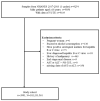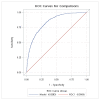Predictive Role of Neutrophil-Percentage-to-Albumin Ratio (NPAR) in Nonalcoholic Fatty Liver Disease and Advanced Liver Fibrosis in Nondiabetic US Adults: Evidence from NHANES 2017-2018
- PMID: 37111111
- PMCID: PMC10141547
- DOI: 10.3390/nu15081892
Predictive Role of Neutrophil-Percentage-to-Albumin Ratio (NPAR) in Nonalcoholic Fatty Liver Disease and Advanced Liver Fibrosis in Nondiabetic US Adults: Evidence from NHANES 2017-2018
Abstract
Nonalcoholic fatty liver disease (NAFLD) is highly prevalent globally and includes chronic liver diseases ranging from simple steatosis to nonalcoholic steatohepatitis (NASH). The neutrophil-to-albumin ratio (NPAR) is a cost-effective, readily available biomarker of inflammation used to assess cancer and cardiovascular disease prognosis, and it may be of predictive value in NAFLD. This study was to evaluate the associations between the NPAR, the neutrophil-to-lymphocyte ratio (NLR), and the presence of NAFLD or advanced liver fibrosis, and to assess the predictive value of the NPAR in NAFLD in a nationally representative database. This population-based, cross-sectional, retrospective study analyzed the secondary data of adults with NAFLD or advanced liver fibrosis extracted from the National Health and Nutrition Examination Survey (NHANES) database 2017-2018. NHANES participants with complete information of vibration-controlled transient elastography (VCTE) and controlled attenuation parameter (CAP) were enrolled. A logistic regression analysis was used to determine the associations between the variables in the participants with and without NAFLD or advanced liver fibrosis. The mean values of the lymphocyte counts, neutrophil counts, NPAR, aspartate aminotransaminase (AST), alanine aminotransaminase (ALT), total cholesterol, triglycerides, and HbA1c were significantly higher in the participants with NAFLD than in those without NAFLD or advanced liver fibrosis. The mean blood albumin levels of the subjects without NAFLD or advancing fibrosis were considerably greater than those of the individuals with these conditions. The mean values of the NLR, NPAR, AST, ALT, triglycerides, lymphocyte count, neutrophil count, and HbA1c were significantly higher in patients with advanced fibrosis than in those without advanced fibrosis. A multivariate analysis showed that per unit increases in both the NLR and NPAR were significantly associated with an increased risk of developing NAFLD, while neither the NLR nor NPAR was significantly associated with higher odds of advanced fibrosis. In conclusion, the novel biomarker NPAR demonstrates a good association with NAFLD, along with participants' clinical characteristics, in a nationwide population. The NPAR may serve as a biomarker for NAFLD and help clinicians refine the diagnosis and treatment of chronic liver disease.
Keywords: National Health and Nutrition Examination Survey (NHANES); liver fibrosis; neutrophil-percentage-to-albumin ratio (NPAR); neutrophil-to-lymphocyte ratio (NLR); nonalcoholic fatty liver disease (NALFD).
Conflict of interest statement
The authors declare no conflict of interest.
Figures



References
-
- Li J., Zou B., Yeo Y.H., Feng Y., Xie X., Lee D.H., Fujii H., Wu Y., Kam L.Y., Ji F., et al. Prevalence, incidence, and outcome of non-alcoholic fatty liver disease in Asia, 1999–2019: A systematic review and meta-analysis. Lancet Gastroenterol. Hepatol. 2019;4:389–398. doi: 10.1016/S2468-1253(19)30039-1. - DOI - PubMed
MeSH terms
Substances
LinkOut - more resources
Full Text Sources
Medical
Miscellaneous

